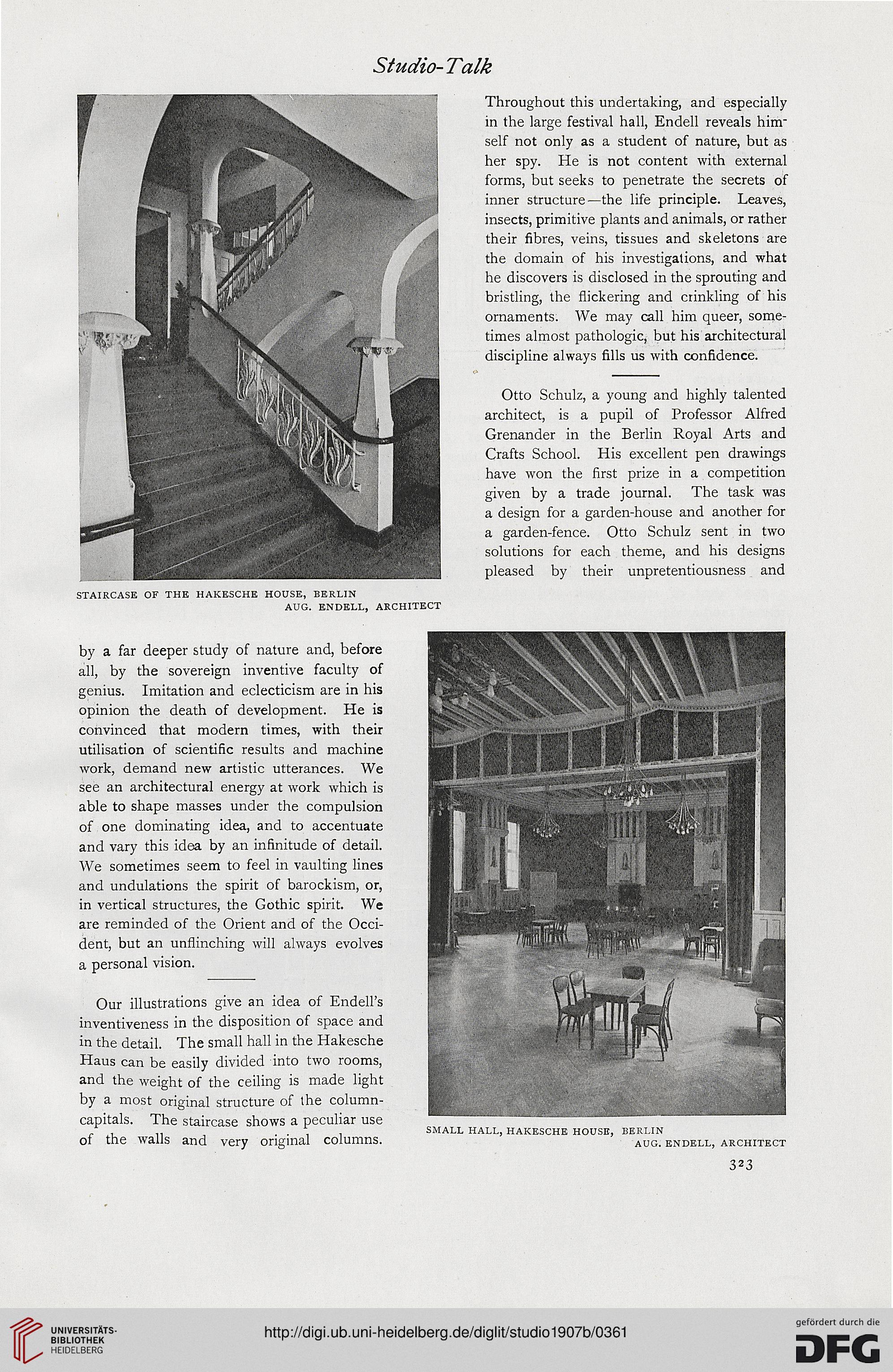Studio-Talk
Throughout this undertaking, and especially
in the large festival hall, Endell reveals him-
self not only as a student of nature, but as
her spy. He is not content with external
forms, but seeks to penetrate the secrets of
inner structure—the life principle. Leaves,
insects, primitive plants and animals, or rather
their fibres, veins, tissues and skeletons are
the domain of his investigations, and what
he discovers is disclosed in the sprouting and
bristling, the flickering and crinkling of his
ornaments. We may call him queer, some-
times almost pathologic, but his architectural
discipline always fills us with confidence.
Otto Schulz, a young and highly talented
architect, is a pupil of Professor Alfred
Grenander in the Berlin Royal Arts and
Crafts School. His excellent pen drawings
have won the first prize in a competition
given by a trade journal. The task was
a design for a garden-house and another for
a garden-fence. Otto Schulz sent in two
solutions for each theme, and his designs
pleased by their unpretentiousness and
staircase of the hakesche house, berlin
aug. endell, architect
by a far deeper study of nature and, before
all, by the sovereign inventive faculty of
genius. Imitation and eclecticism are in his
opinion the death of development. He is
convinced that modern times, with their
utilisation of scientific results and machine
work, demand new artistic utterances. We
see an architectural energy at work which is
able to shape masses under the compulsion
of one dominating idea, and to accentuate
and vary this idea by an infinitude of detail.
We sometimes seem to feel in vaulting lines
and undulations the spirit of barockism, or,
in vertical structures, the Gothic spirit. We
are reminded of the Orient and of the Occi-
dent, but an unflinching will always evolves
a personal vision.
Our illustrations give an idea of Endell's
inventiveness in the disposition of space and
in the detail. The small hall in the Hakesche
Haus can be easily divided into two rooms,
and the weight of the ceiling is made light
by a most original structure of the column-
capitals. The staircase shows a peculiar use
r ,, , . . , , small hall, hakesche house, berlin
ot the walls and very original columns. aug_ bndell) architect
Throughout this undertaking, and especially
in the large festival hall, Endell reveals him-
self not only as a student of nature, but as
her spy. He is not content with external
forms, but seeks to penetrate the secrets of
inner structure—the life principle. Leaves,
insects, primitive plants and animals, or rather
their fibres, veins, tissues and skeletons are
the domain of his investigations, and what
he discovers is disclosed in the sprouting and
bristling, the flickering and crinkling of his
ornaments. We may call him queer, some-
times almost pathologic, but his architectural
discipline always fills us with confidence.
Otto Schulz, a young and highly talented
architect, is a pupil of Professor Alfred
Grenander in the Berlin Royal Arts and
Crafts School. His excellent pen drawings
have won the first prize in a competition
given by a trade journal. The task was
a design for a garden-house and another for
a garden-fence. Otto Schulz sent in two
solutions for each theme, and his designs
pleased by their unpretentiousness and
staircase of the hakesche house, berlin
aug. endell, architect
by a far deeper study of nature and, before
all, by the sovereign inventive faculty of
genius. Imitation and eclecticism are in his
opinion the death of development. He is
convinced that modern times, with their
utilisation of scientific results and machine
work, demand new artistic utterances. We
see an architectural energy at work which is
able to shape masses under the compulsion
of one dominating idea, and to accentuate
and vary this idea by an infinitude of detail.
We sometimes seem to feel in vaulting lines
and undulations the spirit of barockism, or,
in vertical structures, the Gothic spirit. We
are reminded of the Orient and of the Occi-
dent, but an unflinching will always evolves
a personal vision.
Our illustrations give an idea of Endell's
inventiveness in the disposition of space and
in the detail. The small hall in the Hakesche
Haus can be easily divided into two rooms,
and the weight of the ceiling is made light
by a most original structure of the column-
capitals. The staircase shows a peculiar use
r ,, , . . , , small hall, hakesche house, berlin
ot the walls and very original columns. aug_ bndell) architect




